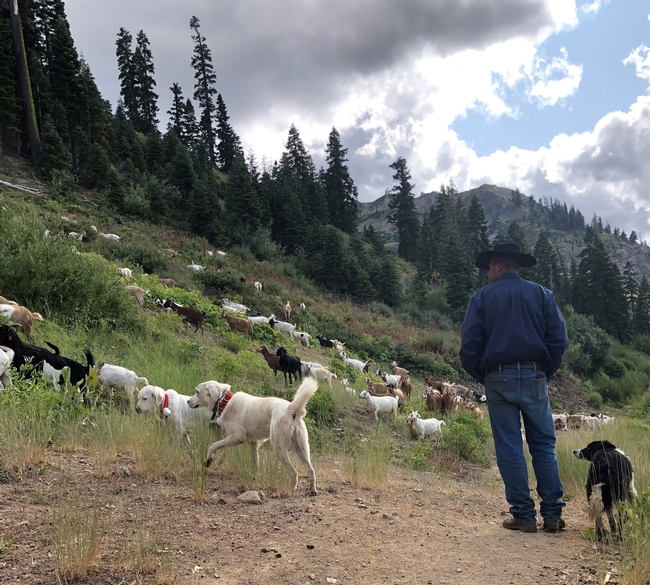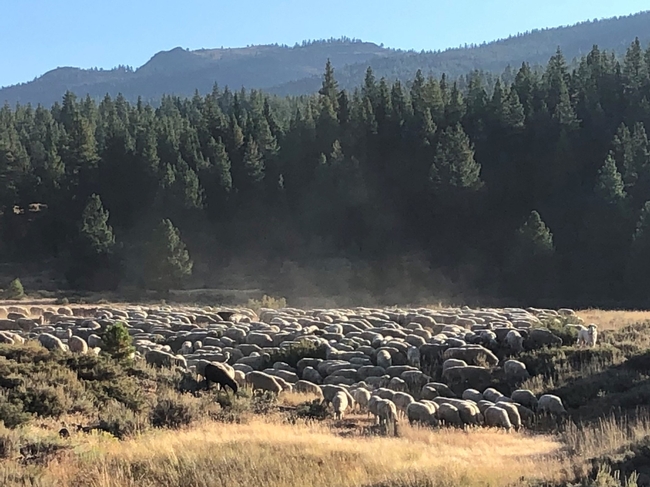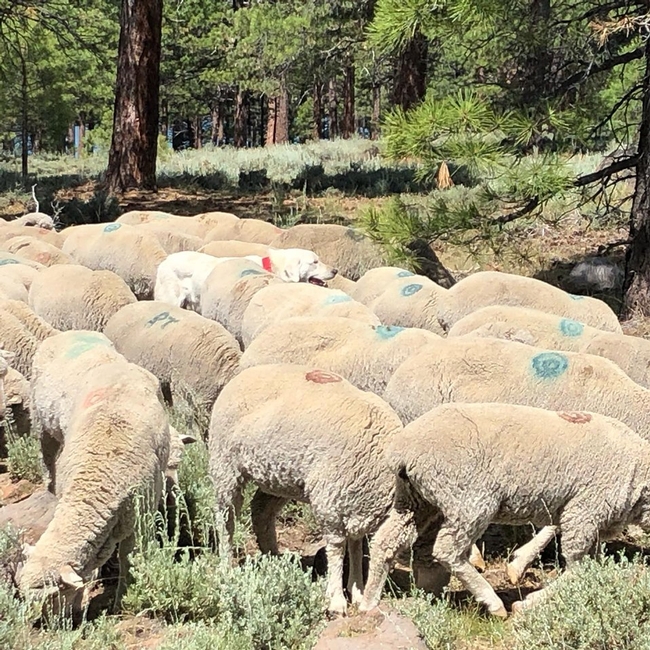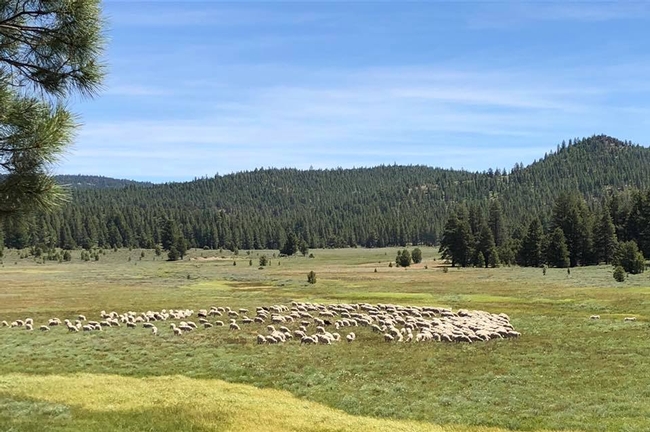- Author: Dan Macon
Like any livestock management tool, livestock guardian dogs come with both costs and (hopefully) benefits. Some of these are easily calculated - for example, through today, we've spent $624.70 on dog food and veterinary costs related to our livestock guardian dogs this year. We currently have 3 dogs (Bodie, a 3-year-old I purchased as a pup for $350; Elko, a 2-year-old given to me as a pup; and Dillon, a 9-month-old pup purchased for $500). Some of the costs and benefits are less easily calculated, however; how do I know how many sheep didn't die because we had dogs with them? What is the value of my own peace of mind? A recent paper by Dr. Ellen Bruno (Cooperative Extension specialist in agriculture and resource economics at UC Berkeley) and Dr. Tina Saitone (CE specialist in agriculture and resource economics at UC Davis) sheds new light on these questions. Read the complete paper here.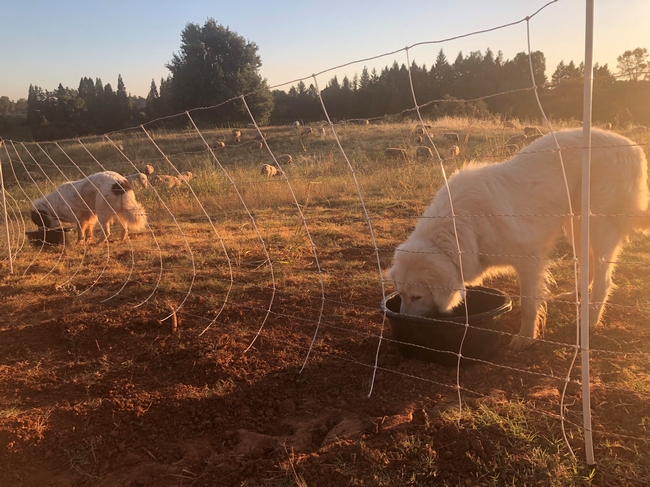
Using data from the University of California's Hopland Research and Extension Center, Bruno and Saitone estimated that dogs reduced lambs lost to coyotes by 43% each year; ewe losses were reduced by 25%. The authors calculated the present value of these prevented deaths over the 7-year useful life of the dogs to be $16,200 (present value calculations were based on the market value of the lambs as well as the value of running-age ewes). Their model was based on using one dog per 100 ewes (more on this below).
On the cost side, the authors included initial purchase of pups, dog food (and labor associated with feeding the dogs), veterinary costs, and dog replacement costs. Labor costs, as they note, are largely dependent on the type of production system - Hopland's labor costs are probably much higher than the typical commercial operation. Using net present value analysis, Bruno and Saitone found that the costs of Hopland's livestock guardian dogs exceeded the benefits (in the value of lambs and ewes not killed by predators) by $13,412 over the seven-year analysis period. In other words, the dogs didn't pay their own way.
Bruno and Saitone offer several important caveats when interpreting these results. First, many ranchers report that dogs eliminate predation entirely (which has been our own experience). If this had been the case at Hopland, the benefits would have exceeded the costs of using dogs by over $12,000. Second, labor-related expenses associated with dogs can be difficult to quantify. In our operation, feeding the dogs is part of our daily check of fences and sheep - we see the sheep every day whether we have dogs with them or not. We charge about 5 minutes per day to feeding 3 dogs - even if I pay myself $20 per hour for this work, our "dog" labor amounts to $371 per dog annually. Hopland, on the other hand, reported labor costs of nearly $1,600 per dog per year. Finally, the authors note that lamb and ewe prices may (and usually do) change from one year to the next - and sometimes dramatically. Sheep values can alter the cost:benefit ratio.
Skeptics might wonder, "Even if you use dogs, if you're not experiencing any predator losses, maybe there aren't any predators around." My ongoing research into livestock guardian dog behavior suggests that there are ALWAYS predators around where small ruminants are grazing (whether on rangeland or irrigated pasture). Using trail cameras, we frequently "capture" coyotes, foxes, and bobcats within 10-15 feet of our sheep paddocks. Interviews with sheep- and goatherders working in the Sierra Nevada indicate that coyotes are heard - and often seen - every night near sheep and goat bed grounds. Though we see them less frequently, we know there are mountain lions and black bears in the vicinity of these operations. The predators are there - the dogs must be at least partly responsible for the lack of predator losses!
As I've written previously, the number of dogs used by producers can vary greatly - from one producer to the next, and from one season to the next on the same operation (see How Many Dogs?). One of the bands of sheep I'm observing near Truckee is guarded by a single dog (band is roughly 1,000 ewes - this scenario is significantly more cost effective than the 1 dog per 100 ewes ratio used in Bruno and Saitone's model). This ratio works because the band is comprised of mature ewes without lambs - and because the predators have plenty of other prey at this time of year. Once this band moves back to Los Banos to lamb on alfalfa stubble later this fall, the dog-to-sheep ratio will increase.
In my experience, peace of mind for the shepherd (or goatherd) can be a significant (if qualitative) benefit. My friends Brad Fowler and Nathan Medlar recently started a targeted grazing project at Squaw Valley Ski Resort north of Lake Tahoe (see Watching Other Dogs). They started the project without livestock guardian dogs (mostly to avoid conflicts with recreationists). They are herding the goats on the ski slopes during the day and penning them at night near their camp (a tent on the side of the mountain). Brad reported that neither they nor the goats slept at all on the first night - the coyotes kept the goats stirred up even though they were protected by electric fence. Brad and Nathan added two dogs on the second day - which relaxed the goats (and the goatherds). Brad reported both herders and livestock slept soundly on the second night.
Finally, research at the U.S. Sheep Center in Dubois, Idaho, found "that ewes grazing with accompanying LGD will travel greater daily distances compared with ewes grazing without LGD accompaniment. As a result of traveling greater distances, ewes may also be exposed to more and varied foraging opportunities." See Webber et al. 2015 for the complete study. To me, this suggests that dogs may make our grazing operations more efficient - allowing us to access forage that would otherwise not get grazed by unprotected livestock. This increased grazing efficiency can reduce our supplemental feed costs.
From my perspective, perhaps the most important part of Bruno and Saitone's work comes at the end of the paper:
"Sheep producers who are considering the purchase of LGDs, or those who already have LGDs and are interested in their return on investment, need a few pieces of data to make this determination. Market lamb and ewe prices are typically well known to producers and can be used, in conjunction with efficacy rates from this study, to estimate the benefits of LGDs.
"On the cost side, producers would need to make some logical forecasts about the time required to maintain LGDs, given their operation specifics.... Also, using guidance from the literature included herein, producers could calculate the likely dog cull and mortality costs of the LGD's useful life."
Ultimately, the success of any livestock protection tool (including lethal control) is highly variable depending on operator characteristics and environmental conditions. Dogs work in our operation because we see the sheep every day and because they are our only option for protecting lambing ewes (we lamb on pasture without access to a lambing shed). Dogs work for the range outfit on the Tahoe National Forest as well; human presence, the vigilance of the dogs, and the stage of production during their time in the mountains virtually eliminates predator losses. And dogs work for the targeted grazing outfits I work with in the foothills and mountains; peace of mind and lack of predator losses justify the costs of keeping dogs in these operations, too.
- Author: Dan Macon
One of the questions I'm asked most frequently when it comes to livestock guardian dogs is, "How many dogs do I need to protect my sheep/goats/cows?" As you might imagine, the short answer is, "It depends." The long answer is more complex. From an economic perspective, the answer is, "As many as it takes to hold predator losses in your operation at an acceptable level, but no more than that." From a production perspective, I've found that the answer depends on operational characteristics, the environment, and the abilities of the specific dog(s).
While it is tempting to try to develop a rule of thumb recommendation (like one dog per 100 ewes), reality is usually more complicated. Wearing my sheepherder economics hat for a moment, the fundamental question comes down to comparing the costs of a dog versus the benefits the dog provides. On the cost side of the ledger, I must account for the cost of dog food, veterinary care, and depreciation. In our operation, these annual expenses amount to roughly $600 per dog. On the benefit side of the ledger, I need to know how many sheep DON'T get killed by predators to determine if my $600 in expenses are justified. Obviously, this is not an easy number to estimate - how can I measure something that doesn't happen? How do I quantify the sheep that might have died had I not had a livestock guardian dog with them? I suspect we'd lose more sheep if we didn't use dogs, but I'm not willing to leave the sheep unprotected to find out!
Operational characteristics, in my experience, play a significant role in determining the optimal number of dogs. Birthing seasons (spring vs. fall), other livestock protection tools (like electric fence, on-site herders, night penning, etc.), grazing management (set stocking versus rotational grazing), and the number of individual herds or flocks all factor into determining the right number. Using our operation as an example:
- We lamb in the late winter and early spring, when there is not a significant natural prey base for the wild predators in our environment. Our lambing paddocks are 7 miles from our home. This argues for more dogs.
- We use electro-net fencing, which definitely deters canine predators (dogs, coyotes and foxes) as well as bobcats. This allows us to get by with fewer dogs.
- We move the sheep frequently - they move to fresh pasture every few days, and graze different properties in spring/summer versus fall/winter. I suspect all of this movement keeps the predators off balance. This allows us to get by with fewer dogs.
- We rarely (if ever) have all of our sheep in one mob. This time of year, the mature ewes are in one flock; the feeder lambs and replacement ewe lambs are in a second flock; the rams in a third location. During breeding season, we have two separate breeding groups plus a group of lambs. This argues for more dogs.
Based on these factors, we feel that we need at least three dogs for our small, part-time operation. With three dogs, we can protect three different groups of sheep or place two dogs together during our most vulnerable time of year (lambing). During some parts of the year, we have more dogs than necessary, which provides flexibility if we begin to have problems with predation.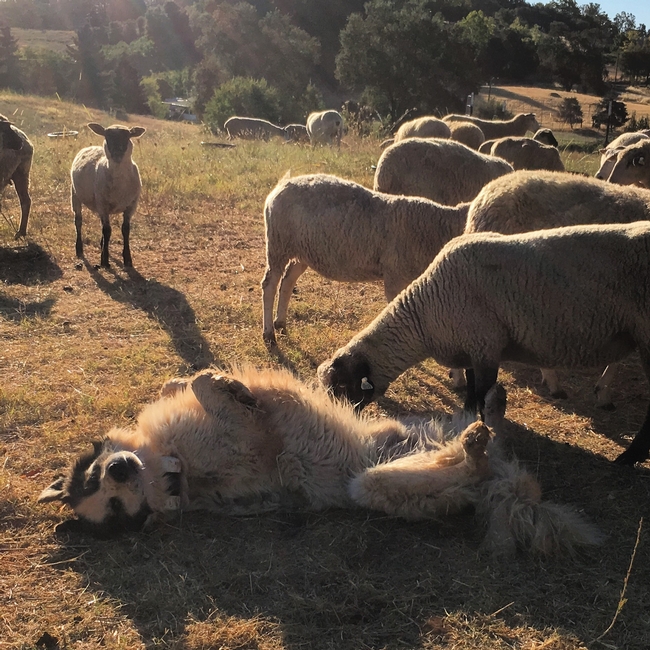
The environment where we're grazing, and the predators it contains, is a second critical consideration. Here in the Sierra foothills (at least at the moment) our main predators (in order of potential threat) are domestic dogs, coyotes, mountain lions, black bears, bobcats, foxes, and birds of prey. I've spoken with ranchers on the north coast who would add crows, ravens, and magpies to that list. And ranchers in northeastern California would add gray wolves. Predator density and prey base also come in to play. Are there several established packs of wolves in the region? Is there sufficient native prey? Are these particular wolves (or coyotes, or mountain lions) known to prey on livestock? Each of these questions are important to consider when determining how many dogs a particular operation might need.
Finally, every livestock guardian dog is an individual. Some are athletic and want to patrol a wide area; others want to stay with their livestock. Some dogs are more canine aggressive than others (an important trait in wolf habitat); others will harass bears. And these traits will change over time - a dog that was aggressive and athletic in his younger days might be content to stay with lambs on irrigated pasture in his later years. In my experience, there is more variation between individuals than there is between livestock guardian dog breeds (a subject for a future blog post!).
Finally, I started a new phase of my livestock guardian dog behavior study this week. I'll be tracking the movements of four dogs (2 each in separate 1000-ewe bands of sheep) grazing on the Tahoe National Forest in Nevada and Sierra Counties (in an area that a collared Oregon wolf has been known to visit in the last 12 months). This is a long-time producer with experienced herders operating on open range with no fences. They typically use two dogs with one band and three dogs with the other, and experience less than one percent death loss while the sheep are on Forest Service allotments. They also have additional dogs they can add to each band if predator problems begin to escalate.
I think this illuminates the "it depends" answer in my first paragraph! They have 1 dog per 400 sheep; we have 1 dog per 51 sheep. They are grazing mature ewes in a relatively wild environment for only 75 days - and at a time when the natural prey base is plentiful. We need more dogs to protect ewes and lambs at an especially vulnerable time of year (and I should note - the large operation needs more dogs at lambing as well). The common thread for each of these operations, however, is that we are constantly evaluating our need for predator protection against the cost of providing it. If we could get by with fewer dogs, we would; similarly, if the large operation needs more dogs this summer, they'll add dogs. In other words, it depends!


